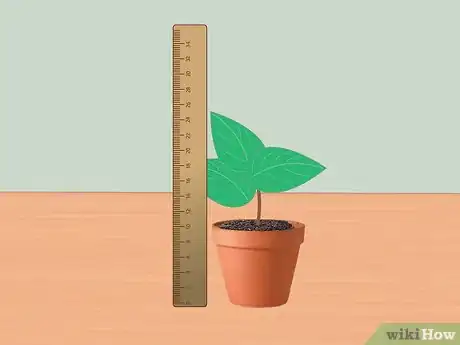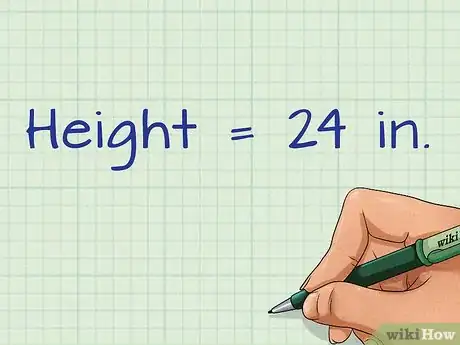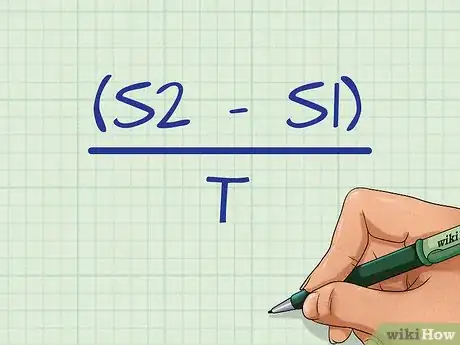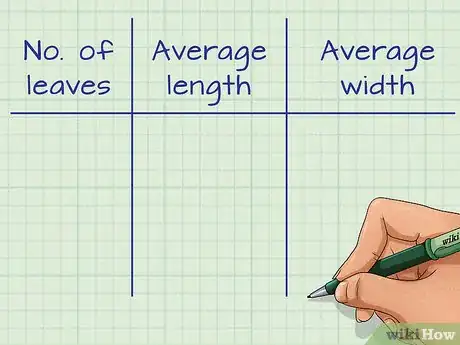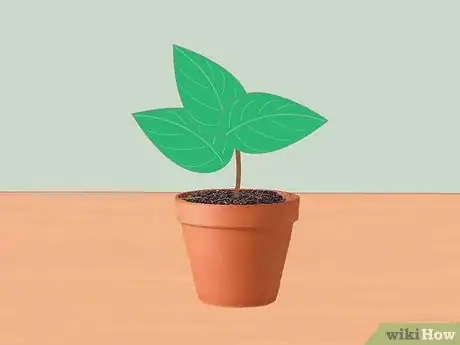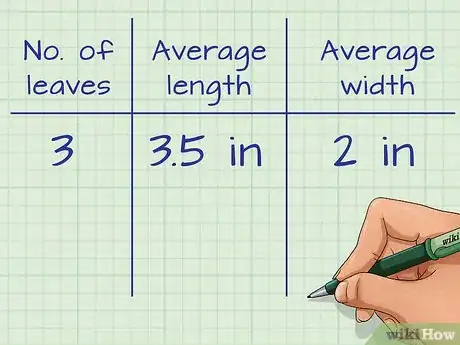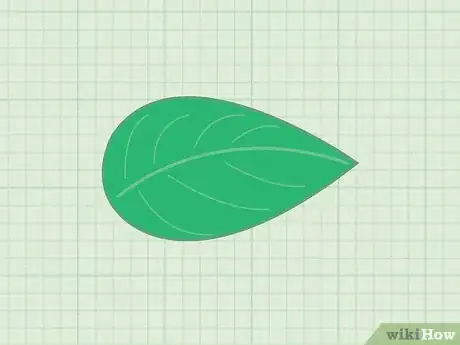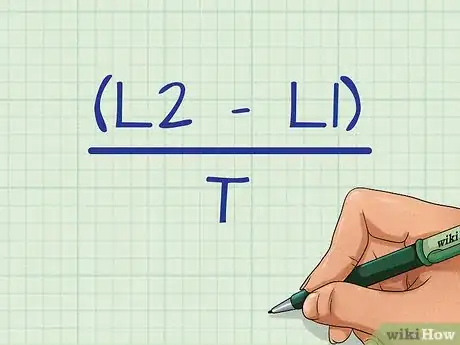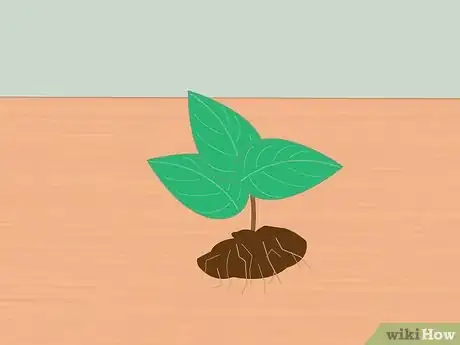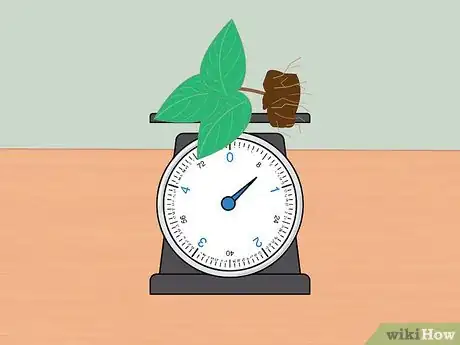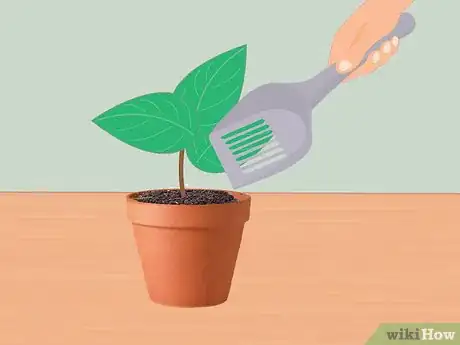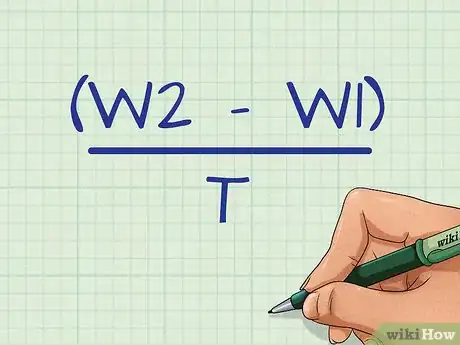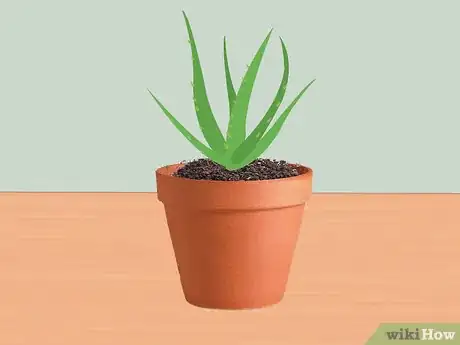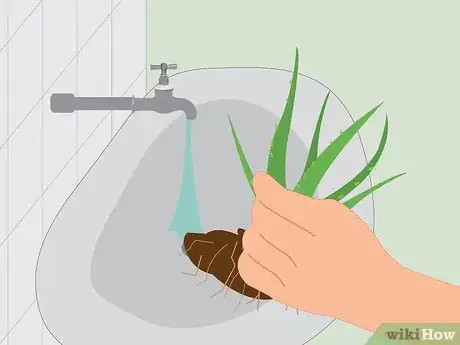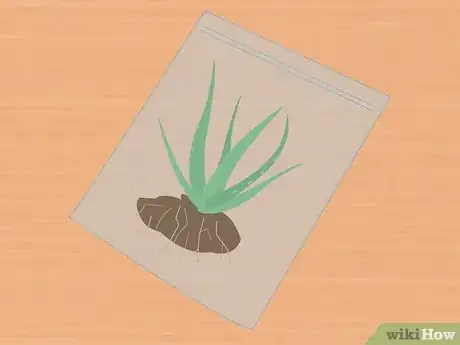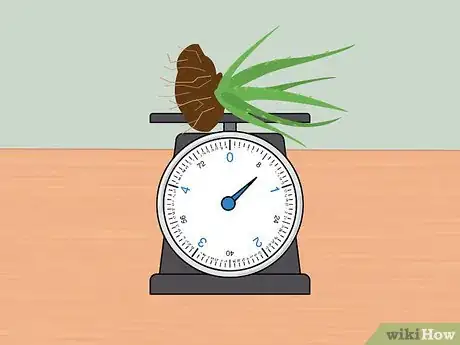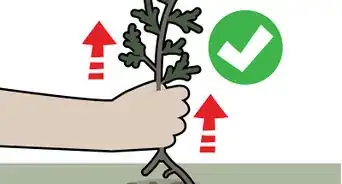This article was co-authored by Andrew Carberry, MPH. Andrew Carberry is a Food Systems Expert and the Senior Program Associate at the Wallace Centere at Winrock International in Little Rock, Arkansas. He has worked in food systems since 2008 and has experience working on farm-to-school projects, food safety programs, and working with local and state coalitions in Arkansas. He is a graduate of the College of William and Mary and holds a Masters degree in public health and nutrition from the University of Tennessee.
There are 12 references cited in this article, which can be found at the bottom of the page.
wikiHow marks an article as reader-approved once it receives enough positive feedback. In this case, several readers have written to tell us that this article was helpful to them, earning it our reader-approved status.
This article has been viewed 297,652 times.
Measuring plant growth is a very simple procedure that can be done quickly. Whether you want to know how quickly your house plants are growing or need to calculate growth rate of lab specimens, you can do so with minimal effort. You only need a few simple supplies and a bit of time to track the plant’s growth rate.
Steps
Measuring Plant Height
-
1Set the ruler at the base of the plant. Smaller plants can be measured with a ruler, while taller plants may require a measuring tape, yardstick, or meter stick. Make sure that the ruler begins at zero on the bottom.[1]
- If you are measuring a plant in a pot, the ruler should begin at ground level.
-
2Record the height of the plant. You will want to measure the plant from its base to its highest point. Write this down in a chart with both the date and the height recorded. Repeat every two to three days.[2]Advertisement
-
3Calculate the average using the growth rate formula. You can see the average daily growth rate by taking the change in size and dividing it by the amount of time it has been growing.
- The equation for the growth rate formula is where S1=first measurement, S2=second measurement, and T equals the number of days between each.[3]
- This is an extremely general figure. Plant growth rate is extremely fluid and can be subject to major variations day by day. Currently, there is no way to accurately predict exact daily growth rate without the use of sophisticated laboratory equipment.
Judging Leaf Size
-
1Create a chart. Your chart should have rows for each date that you measure your leaves. The columns should be labeled “number of leaves,” “average length,” and “average width.” You should check your leaves every two to three days.
-
2Count the leaves on your plant. Be extremely thoroughly, but make sure you do not count the same leaves twice. Include new leaf tips and sprouts in your count. Record the number of leaves down in your chart.
-
3Mark the length and width. Choose a random sampling of four or five leaves. Hold the ruler from the bottom to the tip of the leaf. Add up the measurements, and divide by the number of measurements you took. (For example, if you measured by five leaves, divide by five). This is the average leaf length for that day. Record this down in your chart.
- Repeat this process to find the width of the leaves. Measure the leaves at their widest part.
- Be as specific as possible; get the measurement down to centimeters and millimeters if you can.
-
4Trace your plant's leaves on grid paper. Keeping the leaf on the plant, draw around the leaf on grid paper. The grid should have squares that are one inch in area. Count the number of squares covered to get the surface area of each leaf.
-
5Repeat measurements every two or three days. Leaves can grow quickly. Check the size of your leaves every few days to see how they are growing. You can use a modification of the growth rate formula for this purpose.
- You can calculate the leaf number growth rate. This modification of the growth rate formula will tell you how many leaves are approximately growing per day. The equation for this growth rate is where L1=first leaf count, L2=second leaf count, and T equals the number of days between each.
- The leaf size formula is the same as the plant height formula. Instead of height, the variable is the surface area. The equation for the growth rate formula is where S1=first surface area measurement, S2=second surface area measurement, and T equals the number of days between each.[4]
-
6Create a growth template. Once you have gathered a few weeks’ worth of leaf tracings, you can use those shapes to create a template. Take a piece of paper or cardboard. Take the smallest tracing, and create a circle roughly that size, starting from the bottom of the paper. Create up to six larger circles that contain all of the measurements up to the largest. These should form concentric rings outside of the first circle. Label each of these circles with a number. One should be the smallest and six, the largest.[5]
- In the future, you can use this template to measure leaves with greater ease. Hold up the leaf at the bottom of the paper with it centered around the smallest circle. Mark the largest circle it fills without going over and record that as the leaf size.
Calculating Growth Rate with Fresh Plants
-
1Remove your plant from its pot. Ease a trowel around the edges of the pot. If it is planted in the ground, dig a wide circle around the plant. You do not want to touch the roots. Lift the plant up, and with your fingers, remove the large dirt clumps around the plant.[6] Do not pull or yank the plant out.
-
2Rinse soil from the roots. With a gentle stream of water, wash off dirt from the plant. You can use your fingers to gently ease clumps away. Pat your plant dry with a paper towel.
-
3Place your plant on the scale. Do not wait for it to lose its moisture. Place it on a scale. The scale should be able to read measurements as small as milligrams. Record the weight.[7]
-
4Replace the plant in its pot. Return it to its hole, and cover with fresh soil. If you are potting your plants, place some potting soil in the bottom of a pot before putting the plant back in. Cover with fresh potting soil, leaving an inch between the soil and the lip of the pot.[8] Water the plant to replace any lost moisture.
-
5Wait a month before repeating. You should not weigh your plants often as this can harm the plant by slowing its growth or killing it. As long as you are gentle and do not touch its roots, you may be able to safely remove and weigh the plant a few times, but exercise extreme caution when doing so.
-
6Calculate the growth rate formula. After you have a second measurement, use the growth rate formula to calculate the daily average growth rate. The equation for this growth rate is where W1=first weight, S2=second weight, and T equals the number of days between each.
Finding the Growth Rate with Dried Plants
-
1Choose a random plant. Dry measurements will kill your plant, so you should only do this type of measurement if you have multiple specimens. Choose a random plant, and remove it from its pot. Leave the other plants alone.
-
2Wash off the soil carefully from the roots. With a gentle stream of water, rinse dirt from the plant. You can use your fingers to gently remove clumps. Pat it dry with a paper towel.
-
3Place your plant in the oven. A drying oven is ideal. Set the temperature to 140 Fahrenheit or 60-70 Celsius. Heat the plants for at least 8 to 12 hours and up to two days to dry out the plants.[9]
- If you do not have a drying oven, a food dehydrator set at the same temperature will also work.
- A conventional oven with a convection setting may work as well. Set it at 140 Fahrenheit for six hours. It will dry out the plants well enough, although a little moisture may remain. Do not leave a conventional oven on overnight.
-
4Place your plant in a plastic zip bag. Pinch the zipper closed to prevent moisture from entering. This will keep the plants dry. Allow the plants to cool in the bag.[10]
- If leaves fall off during cooling, keep them. Place the detached leaves on the scale with the rest of the plant.
-
5Weigh your plant. When it is completely cool, place the plant on the scale. Record the weight. This particular plant is now completely destroyed. You may toss out the plant this point.[11]
-
6Calculate the growth rate after repeating. You can take new measurements after a few days, but you may want to wait a week or two. Once you have the new measurements, you can compare them to the old. Use the growth rate formula to find an average change in weight.
- The equation for this growth rate is where W1=first dry weight, S2=second dry weight, and T equals the number of days between each.
Expert Q&A
Did you know you can get expert answers for this article?
Unlock expert answers by supporting wikiHow
-
QuestionWhy can measuring mass help measure the plant's growth?
 Andrew Carberry, MPHAndrew Carberry is a Food Systems Expert and the Senior Program Associate at the Wallace Centere at Winrock International in Little Rock, Arkansas. He has worked in food systems since 2008 and has experience working on farm-to-school projects, food safety programs, and working with local and state coalitions in Arkansas. He is a graduate of the College of William and Mary and holds a Masters degree in public health and nutrition from the University of Tennessee.
Andrew Carberry, MPHAndrew Carberry is a Food Systems Expert and the Senior Program Associate at the Wallace Centere at Winrock International in Little Rock, Arkansas. He has worked in food systems since 2008 and has experience working on farm-to-school projects, food safety programs, and working with local and state coalitions in Arkansas. He is a graduate of the College of William and Mary and holds a Masters degree in public health and nutrition from the University of Tennessee.
Food Systems Expert
-
QuestionSo how do you calculate the rate growth over two weeks?
 Community AnswerIf two weeks is the total period you will be measuring the leaves, you should measure them every two to three days. Keep a chart with each date of measurement clearly marked. For such a short period of time, you should probably do a size measurement, such as measuring height or leaf size, instead of a weight measurement, such as a fresh or dry weighing.
Community AnswerIf two weeks is the total period you will be measuring the leaves, you should measure them every two to three days. Keep a chart with each date of measurement clearly marked. For such a short period of time, you should probably do a size measurement, such as measuring height or leaf size, instead of a weight measurement, such as a fresh or dry weighing. -
QuestionWhich leaf should you use to measure leaf area?
 Community AnswerTry to select a random leaf. While it should be a random leaf, you can avoid certain leaves for a more accurate reading. Do not take a new leaf tip or sprout. Similarly, you should not take a leaf that looks dead.
Community AnswerTry to select a random leaf. While it should be a random leaf, you can avoid certain leaves for a more accurate reading. Do not take a new leaf tip or sprout. Similarly, you should not take a leaf that looks dead.
Warnings
- Use fresh weighing towards the end of an experiment or the plant's lifespan. While you can repeat a fresh measurement, it can damage the plant if done frequently or can disrupt the plant's growth.[13]⧼thumbs_response⧽
Things You'll Need
- Seeds or seedlings
- Planting soil
- Pots
- Garden tools
- Graph paper and/or regular paper
- Tracing paper
- Scissors
- Scale
- Plastic bags
- Paper towels
- Oven for drying
References
- ↑ https://www.researchgate.net/figure/Measuring-plant-height-leaf-sheath-length-and-leaf-sheath-diameter_fig2_282522763
- ↑ https://www.shorttutorials.com/how-to-measure-growth-rate-of-plants/growth-rate-judging-by-plant-height.html
- ↑ https://www.shorttutorials.com/how-to-measure-growth-rate-of-plants/growth-rate-judging-by-plant-height.html
- ↑ https://nph.onlinelibrary.wiley.com/doi/full/10.1111/nph.17610
- ↑ http://ir.library.oregonstate.edu/xmlui/bitstream/handle/1957/39969/EM%209070.pdf
- ↑ https://extension.psu.edu/repotting-houseplants
- ↑ http://www.sciencebuddies.org/science-fair-projects/project_ideas/PlantBio_measuring_growth.shtml
- ↑ https://extension.psu.edu/repotting-houseplants
- ↑ https://bonnieplants.com/library/how-to-dry-your-harvest/
- ↑ https://www.sciencebuddies.org/science-fair-projects/project_ideas/PlantBio_measuring_growth.shtml
- ↑ https://www.sciencebuddies.org/science-fair-projects/project_ideas/PlantBio_measuring_growth.shtml
- ↑ https://hortamericas.com/blog/fresh-weight-vs-dry-weight/
- ↑ http://www.ncbi.nlm.nih.gov/pmc/articles/PMC3231316/
About This Article
To measure a plant’s growth rate, use a ruler or measuring tape to measure from the base of the plant to its highest point. If your plant is in a pot, start your measurement at the base of the pot. Write the measurement down, then repeat 2-3 days later. You can then calculate the average growth rate by subtracting the second measurement from the first measurement, then dividing that number by the number of days between the two measurements. For more tips from our Gardener, including how to track leaf size and weigh fresh plants, read on!
